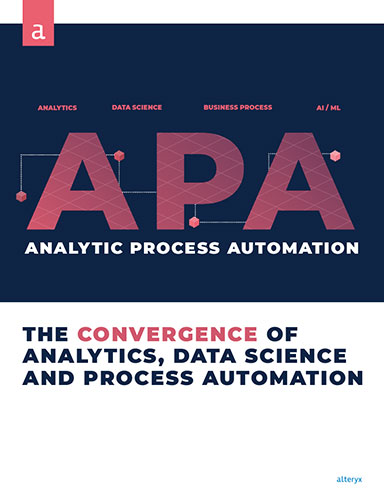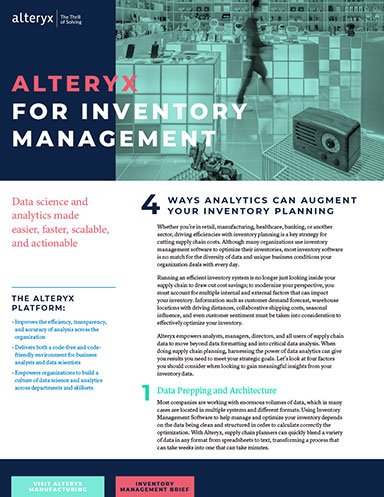Modern-Day Analytic Automation

With modern-day analytic automation, challenges, such as those presented by the COVID-19 pandemic, can be solved through the unification of data, process, and people.
Companies around the world are rapidly adjusting to new realities posed by the COVID-19 global pandemic.
In many cases, the fragility of their supply chain analytics has faced increased scrutiny — customers are experiencing inaccurate shipping times, diminishing inventories (where’s all of the toilet paper gone?), and demand that’s moving faster than supplies can be adjusted — causing them to turn elsewhere, significantly impacting organizations’ bottom lines.
With modern-day analytic automation, these challenges can be solved through the unification of data, process, and people, and for many companies, this creates an incredible competitive advantage.
What is Analytic Process Automation?
Analytic Process Automation (APA) unifies three key pillars of automation and digital transformation to enable the democratization of data and analytics, the automation of business processes, and the upskilling of people for quick wins and transformative outcomes.
Analytic Automation in Practice
Supply chain management systems are optimized based on replenishment times. If you are producing a product, you need to know how long it will take to receive new parts when they’rsquo;re ordered. If the timing is three weeks, the system will look at how many parts will be consumed over that timeframe and if the result is a negative inventory, parts are automatically ordered.
For a company that is responsible for the logistics on large numbers of SKUs, the management of this process needs to be somewhat automated to yield optimal results. However, depending on the type of automation implemented, the results can be dramatically different.
Let’s look at a classic supply chain challenge and illustrate the value of implementing an APA solution.
Company A: The Classic IT System
This company implements a very standard process. An analyst inputs the expected shipping time information when the part is “born” into the system.
The initial estimate placed into the system can have high variation based on the different logic being used by each analyst who inputs these numbers. A more risk-averse analyst could potentially place more time, while a more aggressive analyst might use lower shipping time numbers to optimize inventory.
See the potential for discrepancies? After creating over hundreds of thousands of parts, these timing estimates become even more problematic as seasonality, shipping issues, and the global pandemic skew the shipping times and create large disconnects to the estimates that were placed into the system.
While analysts can work to manually update the fields, it becomes nearly impossible to keep up, and bad estimates result in stock shortage, premium shipping fees to keep production moving, and significant cost and downtime. While this can be corrected with rigorous training and process improvement, it doesn’t eliminate the real challenge.
Company B: The Analytic Approach with Model Management
The traditional analytic approach would be to build a model to estimate the shipping time for each part, and instead of an analyst placing an estimate into the system, the estimate would be automatically created by the model.
This significantly reduces the initial variations, but how does the system deal with the shifting underlying data? For companies that have strong discipline with model implementation, they would likely monitor the model periodically to understand if the data has shifted to the point where new models need to be created.
For most companies, model management happens on an annual, quarterly, or even monthly basis. However, when significant events like a pandemic hit, this can be too long to wait. Again, even more problematic for most of these implementations is that the system is then adjusted for new estimates placed into the system but doesn’t automatically update all the prior estimates being used.
Company C: The Modern Analytic Process Automation Approach
Model monitoring may quickly become an outdated concept as modern analytic tools allow continuous adjustments to the model based on the shifting incoming data.
Instead of monitoring the model, the system automatically adjusts. In this example, the current shipping times are monitored by the system, and as the times shift, the estimated shipping times in the system are all adjusted. This approach can have real-time adjustments occur as the shockwave of a global event occurs.
It’s amazing that so many companies are still struggling to move toward a modern-day approach, as the technology to make this happen is already with us and can be implemented by domain experts.
The shift from an old IT-system approach (Company A) to the modern-day Analytic Process Automation approach (Company C) is now being accomplished in mere weeks, saving companies millions of dollars in both inventory and premium shipping.
Of course, this approach also leverages monitoring of the models, but instead of determining when to create a new model, the goal is to alert when new models are significantly changing so that a human can review and approve the change.
However, creating an optimized supply chain is about more than ensuring orders for supplies are placed and products are delivered to customers. While organizations may think of modeling and AI approaches as the domain of PhDs and large technology projects, other companies are learning that it’s the arming of their workforce with these process automation technologies that leads to transformation and to becoming truly AI-driven.
It’s Not Magic — It’s Automation
It’s not that Company A or B doesn’t have the capability to optimize efficiencies, it’s that they don’t have the ability. They can analyze the data, run reports, deliver insights, and drive winning business solutions, but it takes them longer and is more ad-hoc than operationalized. When the next crisis hits, they’ll still be stuck in reactive mode.
What the resilient companies (like Company C) do isn’t magic, it’s automation. They’re predictive and prescriptive analytic powerhouses because they automate the repetitive tasks and spend time asking the right questions. They apply automation to large volumes of data to increase reporting frequency, able to change parameters and rerun reports as data changes. When crises like a pandemic strike, their analytic processes automatically make hundreds of decisions for them and deliver optimal results in trying times.
At the end of the day, success comes from handling disruption (like the current pandemic) well. And optimization is about more than seeing all the breaking points within a supply chain, it’s about creating revenue opportunities through business transformation and changing the way you operate from the top down. It’s about placing business outcomes first, freeing your employees to find creative solutions to problems, and having an action plan before the next big crisis. It’s about transforming your supply chain.
Related White Papers
The Essential Guide to Analytic Process Automation
With a Analytic Process Automation Platform, fast and efficient transformation is no longer a capital-intensive endeavor. Download Now!
4 Ways Analytics Can Augment Your Inventory Planning
While inventory management is complex, gathering, prepping, blending, analyzing, and auditing your data shouldn’t be. Download Now!
Article Topics
Alteryx News & Resources
Beyond COVID-19: How to Leverage AI and Analytics to Minimize “Supply Chain Disruption” Prepare Your Supply Chain for Uncertainty How to Change Your Supply Chain Inventory Planning Process 4 Ways Analytics can Augment Your Inventory Planning From COVID to Coca-Cola: Analyzing Distribution Models Create Predictive Models in Seconds for Faster and Better Forecasting Modern-Day Analytic Automation More AlteryxLatest in Technology
Spotlight Startup: Cart.com is Reimagining Logistics Walmart and Swisslog Expand Partnership with New Texas Facility Taking Stock of Today’s Robotics Market and What the Future Holds Biden Gives Samsung $6.4 Billion For Texas Semiconductor Plants Apple Overtaken as World’s Largest Phone Seller Walmart Unleashes Autonomous Lift Trucks at Four High-Tech DCs Talking Supply Chain: Procurement and the AI revolution More Technology















